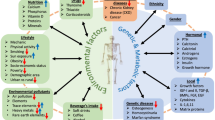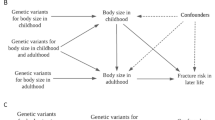Abstract
Risk of osteoporotic fracture in later life relates to both age and menopause-related bone loss but also to peak bone density achieved in early adulthood. Several studies have shown that genetic influences make a major contribution to variance in adult bone density, but environmental factors such as dietary calcium and physical activity also contribute a large proportion of observed variance in bone density. Previous hypotheses have suggested that the effect of certain environmental factors, such as hormonal and dietary influences, may be permissive to development of peak bone mass. Consideration of the evidence for the interaction between environmental influences, such as physical activity and nutrition, and genotype leads us to propose that environmental factors interact to allow or prevent full expression of bone density genotype. This expansion of the ‘threshold’ hypothesis can include the effects of sex, physical activity and dietary calcium in a model that allows more systematic study of the determinants of peak bone density and thereby more rational intervention to augment bone density in early adulthood.
Similar content being viewed by others
References
Pocock NA, Eisman JA, Hopper JL, Yeates MG, Sambrook PN, Eberl S. Genetic determinants of bone mass in adults; a twin study. J Clin Invest 1987; 80: 706–10.
Evans RA, Marel GM, Lancaster EK et al. Bone mass is low in relatives of osteoporotic patients. Ann Intern Med 1988; 109: 870–3.
Dequeker J, Nijs J, Verstaeten A, Geusens P, Gevers G. Genetic determinants of bone mineral content at the spine and the radius: a twin study. Bone 1987; 8: 207–9.
Moller M, Horman A, Harvarld B, Hauge M, Henningsen K, Nordin BEC. Metacarpal morphometry in monozygotic and dizygotic elderly twins. Calcif Tissue Res 1978; 25: 197–201.
Smith DA, Nance WE, Won Kang K, Christian JC, Johnston CC Jr. Genetic factors in determining bone mass. J Clin Invest 1973; 52: 2800–8.
Seeman E, Hopper JL, Bach LA et al. Reduced bone mass in daughters of women with osteoporosis. New Engl J Med 1989; 320: 554–8.
Pocock NA, Eisman JA, Yeates MG, Sambrook PN, Eberl S. Physical fitness is a major determinant of femoral neck and lumbar spine bone mineral density, J Clin Invest 1986; 78: 618–21.
Kelly PJ, Pocock NA, Sambrook PN, Eisman JA. Dietary calcium, sex hormones and bone mineral density in men. Br Med J 1990; 300: 1361–4.
Heaney RP. Calcium, bone health and osteoporosis. In: Peck WA, ed. Bone and mineral research, vol. 4., Amsterdam: Elsevier 1986: 255–301.
Corey LA, Nance WE. A study of dietary intake in adult monozygotic twins. Acta Genet Med Gamellol 1980; 29: 263–71.
Howard H. Ultrastructure and biochemical function of skeletal muscle in twins. Ann Hum Biol 1976; 3: 455–62.
Komi PV, Viitasalo JT, Havu M, Thorstensson A, Karlsson J. Physiological and structural performance capacity: effect of heredity. In: Komi PV, ed. Biomechanics V, Baltimore, MD: University Park Press 1976; 118–23.
Lortie G, Bouchard C, LeBlanc A et al. Familial similarity in aerobic performance. Hum Biol 1982; 54: 801–12.
Lesage R, Simoneau JA, Jobin J, LeBlanc J, Bouchard C. Familial resemblance in maximal heart rate, blood lactate and aerobic power. Human Hered 1985; 35: 182–9.
Monotoye HJ, Gayle R. Familial relationships in maximal oxygen uptake. Hum Biol 1978; 50: 241–49.
Bouchard C, Lesage R, Lortie G et al. Aerobic performance in brothers, dizygotic and monozygotic twins. Med Sci Sports Exerc 1986; 18: 639–46.
Nelson ME, Meredith CN, Dawson-Hughes B, Evans WJ. Hormone and bone mineral status in endurance-trained and sedentary postmenopausal women. J Clin Endocrinol Metab 1988; 66: 927–33.
Orwoll ES, Ferar J, Oviatt SK, McClung MR, Huntington K. 1989; The relationship of swimming exercise to bone mass in men and women. Arch Int Med 1989; 149: 2197–200.
Picard D, Ste-Marie LG, Coutu D et al. Premenopausal bone mineral content relates to height, weight and calcium intake during early adulthood. Bone and Mineral 1988; 4: 299–309.
Elders PJM, Netelenbos JC, Lips P et al. Perimenopausal bone mass and risk factors. Bone and Mineral 1989; 7: 289–99.
Matkovic V, Kostial K, Siminovic I, Buzina R, Brodarec A, Nordin BEC. Bone status and fracture rates in two regions of Yugoslavia. Am J Clin Nutr 1979; 32: 540–9.
Sandier RB, Slemenda CW, LaPorte RE et al. Postmenopausal bone density and milk consumption in childhood and adolescence. Am J Clin Nutr 1985; 42: 270–4.
Baran D, Sorensen A, Grimes J et al. Dietary modification with dairy products for preventing vertebral bone loss in premenopausal women: A three-year study. J Clin Endocrinol Metab 1990; 70: 264–9.
Rubin KR, Schirduan VM, Gendreau P, Dalsky GP. Determinants of peak bone mass in healthy children and adolescence. J Bone Min Res 1989; Suppl 1: abstract 1024.
Riggs BL, Wahner HW, Melton LJ, Judd HL, O'Fallon WM. Dietary calcium intake and rates of bone loss in women. J Clin Invest 1987; 80: 979–82.
Johnston CC. Determinants of bone mass in the elderly. Proceedings of the fifth international Sydney bone symposium, Sydney, Australia, 1990.
Kanders B, Dempster DW, Lindsay R. Interaction of calcium nutrition and physical activity on bone mass in young women. J Bone Min Res 1988; 3: 145–9.
Sinaki M, Wahner HW, Offord KP, Hodgson SF. Efficacy of nonloading exercises in prevention of vertebral bone loss in postmenopausal women: a controlled trial. Mayo Clin Proc 1989; 64: 762–9.
Smith EL, Gilligan C, Smith PE, Sempos CT. Calcium supplementation and bone loss in middle-aged women. Am J Clin Nutr 1989; 50: 833–42.
Block JE, Friedlander AL, Brooks GA, Steiger P, Stubbs HA, Gennat HK. Determinants of bone density among athletes engaged in weight-bearing and non-weight-bearing activity. J Appl Physiol 1989; 67: 1100–5.
Eaton SB, Nelson DA. Calcium in evolutionary perspective. Am J Clin Nutr (Suppl). In press.
Poehlman ET, Tremblay A, Marcotte, Perusse L, Theriault G, Bouchard C. Heredity and changes in body composition and adipose tissue metabolism after short-term exercise training. Eur J Appl Physiol 1987; 56: 398–402.
Depres JP, Bouchard C, Savard R, Prud-Homme D, Bukowiecki L, Theriault G. Adaptive changes to training in adipose tissue lipolysis are genotype dependent. Int J Obesity 1984; 8: 87–95.
Klissouras V, Pirnay F, Petit J-M. Adaptation to maximal effort: genetics and age. J Appl Physiol 1973; 35: 288–93.
Kelly PJ, Twomey L, Sambrook PN, Eisman JA. Sex differences in peak adult bone density. J Bone Min Res 1990; 5 (in press).
Stepan JJ, Lachman L, Zverina J, Pacovsky V, Baylink D. Castrated men exhibit bone loss: effect of calcitonin treatment on biochemical indices of bone remodelling. J Clin Endocrinol Metab 1989; 69: 523–27.
Greenspan SL, Oppenheim DS, Klibanski A. Importance of gonadal steroids to bone mass in men with hyperprolactinemic hypogonadism. Ann Intern Med 1989; 110: 526–31.
Finkelstein JL, Klibanski A, Neer R et al. Increases in bone density during treatment of men with idiopathic hypogonadotrophic hypogonadism. J Clin Endocrinol Metab 1989; 69: 776–83.
Angus RM, Sambrook PN, Pocock NA, Eisman JA. A simple method for assessing calcium intake in Caucasian women. J Am Diet Assoc 1989; 89: 209–14.
Author information
Authors and Affiliations
Rights and permissions
About this article
Cite this article
Kelly, P.J., Eisman, J.A. & Sambrook, P.N. Interaction of genetic and environmental influences on peak bone density. Osteoporosis Int 1, 56–60 (1990). https://doi.org/10.1007/BF01880417
Issue Date:
DOI: https://doi.org/10.1007/BF01880417




